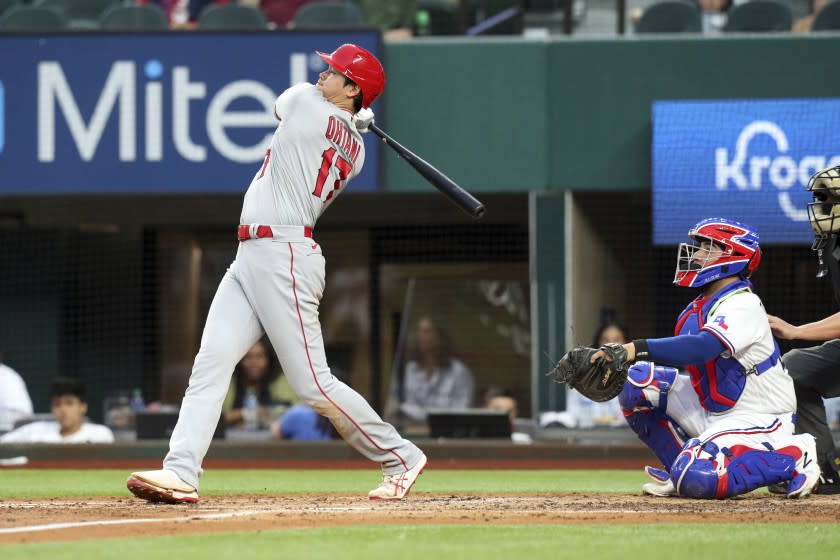Hernández: Shohei Ohtani's Ruthian two-way journey began in Japan, accelerated under Joe Maddon

- Oops!Something went wrong.Please try again later.
- Oops!Something went wrong.Please try again later.
Years ago, when I visited Shohei Ohtani’s high school alma mater in the northern part of the Japanese mainland, baseball coach Hiroshi Sasaki mentioned that he instructs his pitchers to swim as part of their workouts.
Ohtani was a particularly fast swimmer, Sasaki told me.
How fast?
“The swimming coach here said he could have made the Olympics,” Sasaki said.
I laughed politely.
I didn’t include the quote in the 2,800-plus word story I filed from Japan, but, in retrospect, I should have. Sasaki probably wasn’t kidding.
Ohtani really can do just about anything.
Bunt, even.
In a 9-4 win over the Texas Rangers on Monday night, Ohtani threw a baseball 99 mph and also hit one 114 mph. He was charged with four runs while battling command problems in a 29-pitch first inning, but blanked the Rangers over the following four to earn his first win in 1,072 days.
Offensively, he scored three runs and drove in two more on a second-inning double. And with the infield shifted to the right in the fifth inning, he bunted down the third-base line for one of his two hits.
Classic pitcher bunting. 🤣
That's Ohtani's second hit tonight. 👀 pic.twitter.com/dWvbHrEfFq— MLB (@MLB) April 27, 2021
“Pretty complete game of baseball,” Angels manager Joe Maddon said.
Asked if he knew whether Ohtani practiced bunting, Maddon replied, “I have no idea.”
So, evidently, his ability to do so properly was also news to his manager.
But the people watching Ohtani aren’t the only ones learning about the once-in-a-century talent, who became the first pitcher to start a game while at least sharing the league lead in home runs since Babe Ruth in 1921.
Ohtani is also making discoveries about himself, about the extent of his gifts.
“Until now, to some degree, it was decided I would rest on days before I pitched,” Ohtani said. “So it’s the first time it’s been like this.”
Maddon has gone against the conventional wisdom of the time, which is to handle talented players as if they’re made of glass, and removed the usage restrictions designed to keep Ohtani healthy.
“Well, he came here for a reason,” Maddon said. “He was signed to do two things, as far as I can remember. So why would you go out, recruit the guy, bring him in for a specific purpose, and not permit him to try to do that? That makes no sense to me.”
In the short-term, at least, the approach has benefitted Ohtani. He has gained confidence in his durability to where he’s telling Maddon not only that he can hit on days he pitches, as he did Monday, but also the days before and after. Ohtani played in left field over the weekend, which he volunteered to do because the Angels’ bench was depleted.
He’s basically now an everyday player who pitches every six or seven days.
Rather than diminish his production, the increased workload has enhanced it. His seven homers are tied for the most in the American League. He’s tied for fifth in the entire majors in runs and sixth in runs batted in.
His personality has emerged in the process. He pointed in the air after his last home run. He’s stared down an opposing pitcher who struck him with a pitch.
When he was in the middle of everything Monday, it was almost expected.
“I had to put the hold sign on,” Maddon said. “He wanted to steal, too.”
Ohtani has batted in two of the three games he has pitched, each time marking a significant gamble on Maddon’s part. Once a pitcher bats, his team forfeits the designated hitter. The rule adds to Ohtani’s sense of responsibility to remain in the game as long as possible.
“There is pressure, of course,” Ohtani said.
But Ohtani responded to that. He found his control after the rocky first inning and was never threatened again. He finished with nine strikeouts.
This isn’t the first time Ohtani has taken on extra responsibilities and thrived.
When he was a senior at Hanamaki Higashi High School, Japanese professional teams wanted him as a hitter. Major league teams viewed him as a pitcher.
As the 18-year-old Ohtani deliberated his future, the Nippon Professional Baseball team that won his draft rights offered him an alternative: to be a two-way player.
This is important to note, how the idea of Ohtani playing both ways was the Nippon-Ham Fighters’ and not Ohtani’s, just as how the idea to remove the imaginary bubble wrap from Ohtani was Maddon’s and not Ohtani’s.
And similar to how he surprised the Fighters back then, he’s surprising the Angels now. The guess here is that he’s also surprising himself.
Such is the enormity of his tale.
This story originally appeared in Los Angeles Times.

